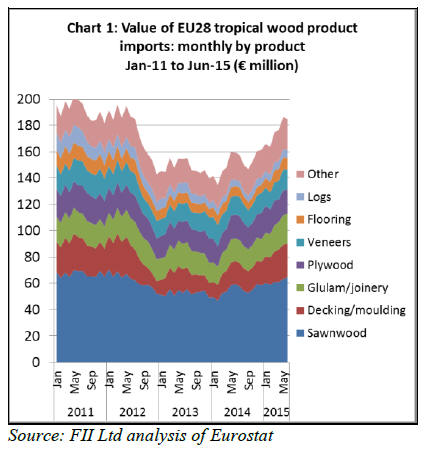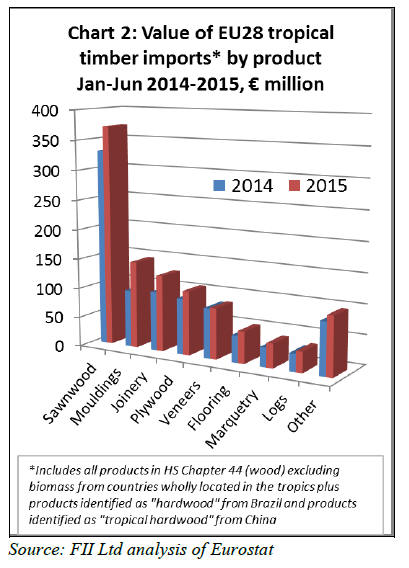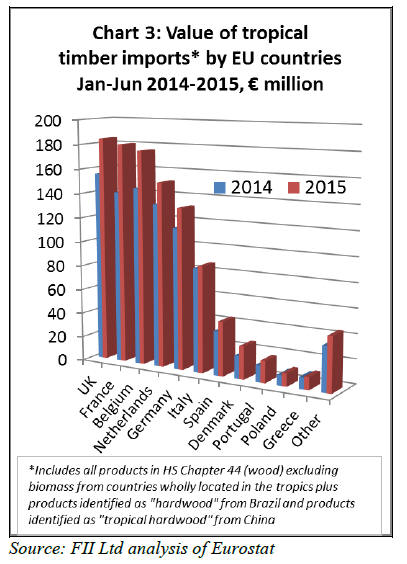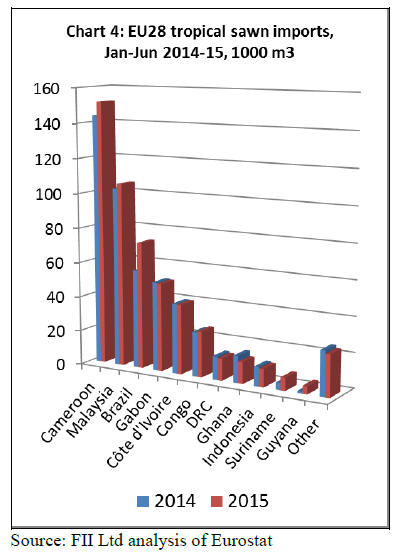|
Report from
Europe
Recovery in EU tropical wood imports
The rising trend in EU tropical wood product imports that
began in September 2014 continued into the second
quarter of 2015. EU imports of tropical wood products in
May 2015 hit €186 million, the highest monthly figure
since June 2012 (Chart 1).
Overall in the first 6 months of 2015, the EU imported
€1.07 billion of tropical wood products, an increase of
19% compared to the same period the previous year.

The strong growth in the value of EU imports this year
should be set against the background of particularly low
levels of import in 2014. The weakness of the euro on
currency exchange values also means that the value of
imports has risen more rapidly than quantity (since the
euro price of imported products tends to be higher).
It is too early to tell whether the recent growth in imports
is the beginning of a lasting recovery or driven mainly by
stock replenishment as importers take advantage of better
availability.
The supply situation for tropical timber in Africa, which
was difficult throughout 2014, has improved this year
from European buyers‟ perspective. Although China
continues to consume large quantities of African timber,
demand in China has eased creating a better balance
between supply and demand for European importers.
A positive trend on the consumption side in Europe is
continued good construction activity in Germany, Europe's
largest economy, and on-going recovery in construction in
the Netherlands, UK, Spain and Eastern Europe.
European furniture production is also improving, with
rising activity in Sweden and UK and strong growth in
Poland, Lithuania and several other Eastern European
countries.
This, together with continuing stability in Germany‟s large
furniture manufacturing sector, is offsetting historically
low levels of furniture production in Italy, Spain and
France.
A particularly encouraging sign this year is that the growth
in EU imports of tropical wood is occurring despite
continuing weakness of the euro-exchange rate which,
other things being equal, makes imported products less
price competitive in the euro-zone.
The growth trend has benefitted suppliers irrespective of
whether they typically invoice in euros or dollars ¨C hinting
that this may be driven more by improving EU
consumption than by short-term stock replenishment.
Imports rise across most tropical wood sectors
The growth also extends to a wide range of products and
market sectors. EU imports of nearly all tropical product
types have increased significantly in the first half of 2015
compared to the same period in 2014 (Chart 2).
EU imports of tropical sawnwood were €371 million in the
first half of 2015, 13% more than the same period in 2014.
Imports of tropical mouldings (including both decking and
interior mouldings) increased 52% to €146 million.
EU tropical plywood imports were 14% greater at €108
million. Imports of tropical joinery products (mostly LVL
for window frames) increased 29% to €128 million, while
tropical flooring products increased 18% to €53 million.

EU tropical log imports jumped 16% to €35 million in the
first six months of 2015, the first turnaround after several
years of continuous decline.
The first very tentative signs of improvement are also
evident in the EU tropical veneer trade. Imports were €86
million in the first half of 2015, 2.2% up compared to the
same period in 2014.
Key tropical timber markets are bouncing back
There was significant growth in the euro value of tropical
timber imports in nearly all the main EU markets in the
first half of 2015 (Chart 3).

The UK was the largest EU destination for tropical wood
products in the first half of 2015, although this position is
now threatened as France and Belgium are now bouncing
back more rapidly.
UK imports of tropical timber products were valued at
€184.4 million in the first half of 2015, 19% more than the
same period in 2014. During the same period, imports
increased 28% to €180.2 million in France and 21% to
€175.8 million in Belgium.
Amongst other western European markets for tropical
wood products, only Italy and Sweden have been
disappointing this year.
In the first half of 2015, Italy‟s imports of tropical wood
products were €87.1 million, only 2% above the
historically low levels recorded in 2014. Imports by
Sweden were €10.1 million in the same period, 5% below
last year‟s level.
Other western European markets for tropical wood are
gaining ground. In the first half of 2015, there was
significant growth in imports by the Netherlands (+13% to
€151.3 million), Germany (+14% to €132.1 million),
Spain (+23% to €44.6 million), Denmark (+44% to €26.9
million), Portugal (+29% to €17.8 million), Greece (+12%
to €10.4 million), and Ireland (+42% to €9.4 million).
Imports of tropical wood products into several Eastern
European countries also increased in the first half of 2015
notably Poland (+24% to €10.5 million), Romania (+26%
to €10.5 million) and the Czech Republic (+72% to €3.8
million).
10% growth in EU tropical sawn hardwood imports
The EU imported 519,000 m3 of tropical sawn hardwood
in the first half of 2015, 6% more than the same period in
2014. The rise was broadly based being recorded across a
wide range of supply countries (Chart 4).

In the first half of 2015, EU imports of tropical sawn
timber increased from Cameroon (+5% to 151,700 m3),
Malaysia (+3% to 105,700 m3), Brazil (+29% to 72,900
m3), Republic of the Congo (+3% to 26,300 m3),
Suriname (+85% to 7,400 m3) and Guyana (+258% to
4,500 m3). Imports from Gabon (50,700 m3) and Ivory
Coast (40,100 m3) were the same as the previous year.
However imports declined from DRC (-7% to 12,600 m3)
and Ghana (-20% to 12,500 m3.
On the recipients‟ side, in the first half of 2015, imports of
tropical sawn hardwood increased into Belgium (+15% to
144,500 m3), the Netherlands (+6% to 106,500 m3),
France (+9% to 69,700 m3), Spain (+32% to 28,400 m3),
Portugal (+17% to 15,900 m3), Ireland (+68% to 7,500
m3) and Denmark (+50% to 6,900 m3).
However imports declined in the first half of 2015 into
Italy (-5% to 59,400 m3), the UK (-21% to 38,500 m3)
and Germany (-12% to 28,500 m3) (Chart 5). Imports into
Italy and Germany picked up a little in the second quarter
of 2015 after a slow start to the year.
In contrast, imports by the UK were good in the first
quarter of 2015 but slowed dramatically in the second
quarter.

Turnaround in tropical log imports
After roughly ten years of almost uninterrupted decline,
EU tropical log imports increased 22% to 82,679 m3 in the
first half of 2015. Much of this growth was due to an 84%
increase in imports from Cameroon to 18,912 m3.
The scale of the increase is partly due to the particularly
low level of imports from Cameroon in the first half of
2014 when trade was seriously disrupted by logistical
problems at Douala port.
There was also a surge in imports in the first half of 2015
from the Central African Republic (+241% to 10,152 m3)
and Suriname (+621% to 2212 m3).
In the first half of 2015, EU tropical log imports from the
DRC (18,016 m3) and Republic of Congo (17,883 m3)
were nearly stable compared to the previous year. Imports
from Liberia were down 48% at 2851 m3 in the first half
of 2015, with nearly all this volume arriving in the first
three months of the year.
Although Myanmar implemented a log export ban from 31
March 2014, Eurostat statistics indicate the EU imported
649 m3 of logs from the country in the first 6 months of
2015, 78% less than the same period in 2014 (Chart 6).

Sharp rise in imports of decking and mouldings
EU imports of ¡°continuously shaped¡± wood (HS code
4409), which includes both decking products and interior
decorative products like moulded skirting and beading,
were 123,436 m3 in the first half of 2015, up 22%
compared to the same period in 2014.
This increase was primarily attributable to much higher
deliveries from the two main suppliers, Indonesia and
Brazil (Chart 7). Imports from Indonesia increased 24% to
52,187 m3. Indonesia has profited from the better demand
in the Netherlands and Germany, traditionally major
markets for Indonesian decking.
Meanwhile EU imports from Brazil were up 28% at
45,142 m3, with a particularly significant increase in
imports by Belgium and France. Imports of Brazilian
decking were constrained last year after a Greenpeace
campaign raising concerns about the legitimacy of
documentation to demonstrate legal origin of Brazilian
tropical timbers.
This encouraged suspension of sales of Brazilian decking
products by several large European merchants and
blockage of shipments while Belgium‟s Environment
Ministry undertook EUTR-related investigations.
These subsequently confirmed the legality of the
shipments which were cleared for entry. The trade data
confirms that EU imports of Brazilian decking products
were flowing more freely during the first half of 2015.

Drilling down into due diligence
The Global Timber Forum (GTF) has published an
international Supplier and Consumer Due Diligence
Analysis which assesses how well companies understand
the concept of ¡°due diligence¡± as it is defined in the EU
Timber Regulation (EUTR), and to assess how far they
have been able to put it into practice.
Under report author George White, a team of interviewers
issued a questionnaire to 27 EU „operator‟ importers,
which have to undertake due diligence illegality risk
assessment of all suppliers under the EUTR. They also
quizzed 15 supplier companies (all in tropical countries),
which today face a mass of due diligence documentation
and inquiries from customers EU-wide.
Critically, they focused on small to medium sized
enterprises, which not only comprise a large part of the
timber sector, but may find due diligence more of a burden
as they have fewer resources to devote to it.
Among aspects the questions probed were:
 whether companies properly
understood what whether companies properly
understood what
was expected of them in terms of due diligence
 how much time, money and people
they devoted how much time, money and people
they devoted
to it
 whether they used external due
diligence support whether they used external due
diligence support
and guidance
 how EU companies viewed the
performance of how EU companies viewed the
performance of
Competent Authorities, responsible for
monitoring and policing the EUTR in each EU
country
Key conclusions included that most companies had a good
understanding of their due diligence obligations, but the
knowledge of some was seriously deficient. The report
also ranks due diligence understanding and performance of
EU company participants by country.
The GTF found that bigger businesses generally had more
comprehensive due diligence policies, but smaller
companies can also perform well. Those that used
external support also had more robust systems and,
interestingly, supplier country companies tended to put
relatively more money and time into due diligence than
their EU customers.
This last conclusion may go some way to explaining why,
as implied by the recent revival in EU imports, European
buyers now seem sufficiently confident of the legality
assurances provided by suppliers to increase purchases of
tropical timber products.
The report is available from the GTF website at:
http://gtf-info.com/uploads/documents/gtf-supplier-andconsumer-
due-diligence-analysis.pdf
|